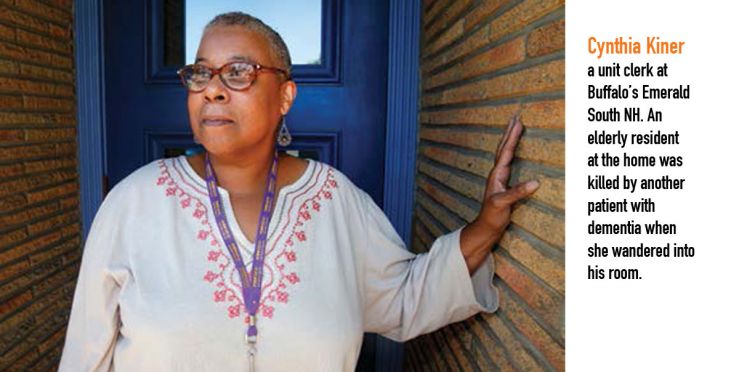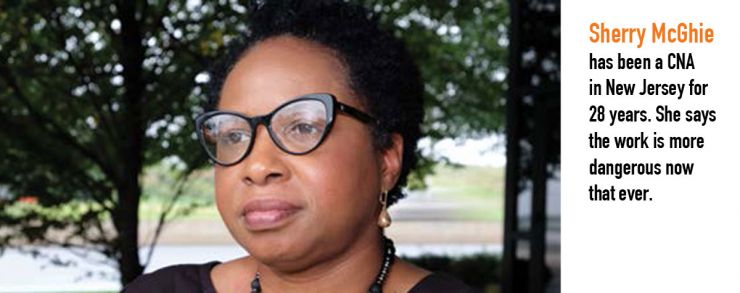Nursing Home Workers in Danger
November 1, 2018
Caregivers demand improved staffing and safety.

It’s well-known that healthcare workers face some of the highest rates of accidental injury on the job, but it’s less well-known that health and social service workers are facing significantly increasing risk of onthe- job violence. A toxic cocktail of understaffing, inadequate policy and mentally and emotionally unstable patients can have deadly results. In September 2016, Ruth Murray, an 83-year-old Alzheimer’s patient at Buffalo, New York’s Emerald South Nursing and Rehabilitation Center, wandered into the room of another patient, and a fight broke out. Murray was beaten to death by the resident, who was known to be easily agitated and aggressive.
“Before that incident happened, we tried to tell them that [he] was patient who needed to be medicated and to send him out for medication and supervision,” says Cynthia Kiner, who for most of her 34 years at Emerald South worked as a CNA until recently taking a position as a unit clerk. “This was a patient who dragged two men out of their beds because he thought they were in his house. He was diagnosed with Alzheimer’s and dementia. He is a big strong man who used to be a roofer. I cringe when I think about what happened to Ruth.”
“Ruth was just a little, thin lady. She didn’t know how to get out of that room. She needed to be directed,” Kiner continues. “What happened to her could have been prevented.”
Kiner describes working conditions with inadequate staff stretched to their limits and the impossibility of keeping an eye on every patient at every moment.
“You know, when I first started this work if you had somebody young on your unit it was big to-do. They have closed so many hospitals and psych units and now they’ve started putting people in our nursing homes; our locked unit is all under 50 years old,” says Kiner. “When I first started we had good people who made sure things were done right. We had staff and weren’t always working short. Sometimes patients were challenging, but you had a team and you could work together. It’s not like that now.”
The National Institute for Occupational Safety and Health defines workplace violence as “violent acts, including physical assault and threats of assaults, directed by a person at work or on duty.” In healthcare, workplace violence-related injuries outpace other areas of the private sector by five times. According to a 2013 report from the U.S. Bureau of Labor Statistics (BLS), more than one quarter of the deaths that occurred in a social service or healthcare setting were the result of assault. Kinei says Ruth Murray’s death is sad evidence that workers’ warnings about short staffing are not hyperbole.
“We have drug users. We have people come to our facility directly from jail. We have a lot of younger, strong people — especially men — in our patient populations.”

Sherry McGhie, a CNA from Paterson, NJ, estimates that nursing home work is more physically dangerous than ever and cites a seismic shift in patient population driven by owners’ priorities. Nursing home managers keep filling beds but do not increase staff in line with the more challenging workload.
“We have patients who have serious mental health issues on top of Alzheimer’s. And they are often as young as 55. They get into fights with our elderly patients,” she says.
“You wind up having to referee and between two people with mental illness it can be impossible. We endure all kinds of verbal abuse and our lives are threatened, and the owners just think it’s okay.”
The BLS report lists a host of environmental and organizational risks that increase the prevalence of workplace violence. They include: working directly with patients with a history of violence, transporting patients and clients, working alone in patients’ rooms, understaffing, high turnover and inadequate security.
A 2016 report in The Sacramento Bee characterized the population change as creating a “dangerous mix” for California’s nursing home workers. The rate of schizophrenia and bipolar disorder increased by about 60 percent between 2000 and 2014, data show. Rising even more quickly is the number of patients under the age of 65.
“We are getting a lot of psychiatric admissions,” says McGhie. “It’s not a lot of elderly people any more the way it used to be. We have drug users. We have people come to our facility directly from jail. We have a lot of younger, strong people — especially men — in our patient populations.”
Jackie Jones, a housekeeper at Dry Harbor Nursing Home in Queens, NY, says workers need to keep organizing and speaking out around staffing and safety. She points to the efforts of 1199 NJ and Upstate.
“I helped organize my workplace. We didn’t like what was going on, so we called 1199 and brought the Union in to change things,” says Jones. “We have to keep doing the same thing now. If we don’t like something we have to work together to change it. When I started at Dry Harbor it was mostly a nursing home for elderly folks and it’s not that way now. I see how our CNAs are talked to. It’s like an alligator biting their heads off, and it’s not right.”
1199 Magazine | September - October 2018

